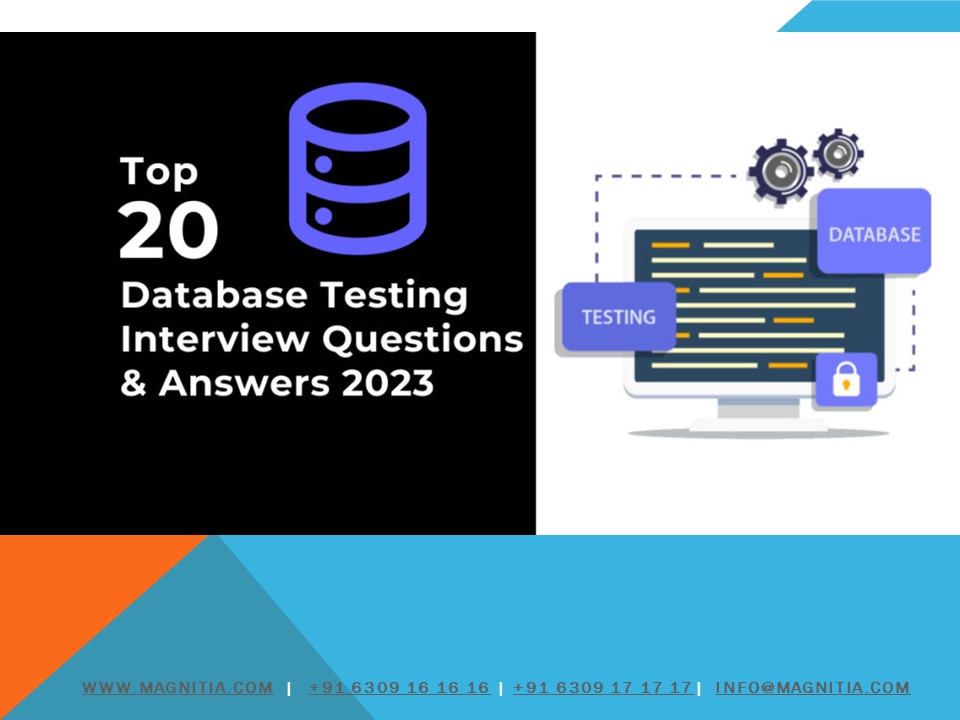Top 20 Database Testing Interview Questions & Answers 2023 - PowerPoint PPT Presentation
Title:
Top 20 Database Testing Interview Questions & Answers 2023
Description:
Here are the top 20 database testing interview questions and answers: – PowerPoint PPT presentation
Number of Views:0
Title: Top 20 Database Testing Interview Questions & Answers 2023
1
(No Transcript)
2
1) What is database testing? Database testing
is a process of verifying the functionality,
performance, and reliability of a database. It
involves checking data integrity, consistency,
and accuracy. 2) What are the different types of
database testing? The different types of
database testing include functional testing,
performance testing, security testing,
scalability testing, and data integrity
testing. 3) What is data integrity
testing? Data integrity testing ensures that
data is accurate, consistent, and reliable. It
involves verifying constraints, relationships,
and rules defined in the database schema.
3
4) What is SQL injection? How can it be
prevented? SQL injection is a technique used by
attackers to insert malicious SQL statements into
an applications database query. To prevent SQL
injection, use parameterized queries or prepared
statements, input validation, and escape special
characters. 5) What is a stored procedure? A
stored procedure is a set of SQL statements that
are stored in the database and can be executed
repeatedly. It is used to encapsulate logic and
improve performance.
4
6) What is normalization in database
testing? Normalization is a process of
organizing data in a database to eliminate
redundancy and improve data integrity. It
involves dividing large tables into smaller ones
and defining relationships between them. 7) What
is the difference between primary key and unique
key? A primary key is used to uniquely identify
a record in a table and cannot contain duplicate
or null values. A unique key, on the other hand,
allows null values but does not allow duplicate
values.
5
8) What is the purpose of the ACID properties in
database testing? The ACID properties
(Atomicity, Consistency, Isolation, Durability)
ensure that database transactions are reliable
and maintain data integrity. They define the
properties that guarantee the success or failure
of a transaction. 9) What is the difference
between a database and a data warehouse? A
database is a collection of related data
organized and structured for efficient retrieval,
storage, and management. A data warehouse, on the
other hand, is a large repository of data
collected from various sources for analysis and
reporting. 10) How do you test database
performance? To test database performance, you
can use techniques like load testing, stress
testing, and performance monitoring. Measure
response times, throughput, and resource
utilization to identify bottlenecks and optimize
performance.
6
11) What is a deadlock in database testing? A
deadlock occurs when two or more processes or
transactions are waiting for each other to
release resources, resulting in a standstill. It
can be detected and resolved using techniques
like deadlock detection algorithms and resource
scheduling. 12) What is data migration
testing? Data migration testing is the process
of validating the successful transfer of data
from one system to another. It involves verifying
data integrity, accuracy, and completeness after
the migration process. 13) What is the purpose
of a database schema? A database schema defines
the structure, organization, and relationships of
a database. It includes tables, fields,
constraints, and indexes that define how data is
stored and accessed.
7
14) What is the difference between a clustered
and a non-clustered index? A clustered index
determines the physical order of data in a table,
and there can be only one clustered index per
table. A non-clustered index is a separate
structure that provides a faster access path to
the data but does not determine the physical
order. 15) What is the difference between a
backup and a restore in database testing? A
backup is a process of creating a copy of the
database or its components for disaster recovery
or data preservation. A restore is the process of
retrieving the backup and returning the database
to its previous state. 16) How would you test
data accuracy in a database? To test data
accuracy, you can compare the data in the
database with the expected values or use data
profiling techniques. Validate data against
business rules, conduct data integrity checks,
and reconcile data from different sources.
8
17) What is a database trigger? A database
trigger is a set of actions that are
automatically performed when a specific event
occurs in a database. Triggers are used to
maintain data integrity, enforce business rules,
or perform automated tasks. 18) What is the
purpose of referential integrity in database
testing? Referential integrity ensures that
relationships between tables are maintained
correctly. It enforces the consistency and
validity of data by defining constraints such as
foreign key relationships. 19) What are some
common database testing tools? Some common
database testing tools include SQL Server
Management Studio (SSMS), Oracle SQL Developer,
MySQL Workbench, DbUnit, and JUnit.
9
20) What are some important considerations for
database security testing? Important
considerations for database security testing
include testing user access controls, encryption,
authentication mechanisms, database permissions,
vulnerability scanning, and auditing. These are
just a few sample questions and answers to help
you prepare for a database testing interview.
Make sure to go deeper into each topic and
practice hands-on exercises to gain a thorough
understanding.































